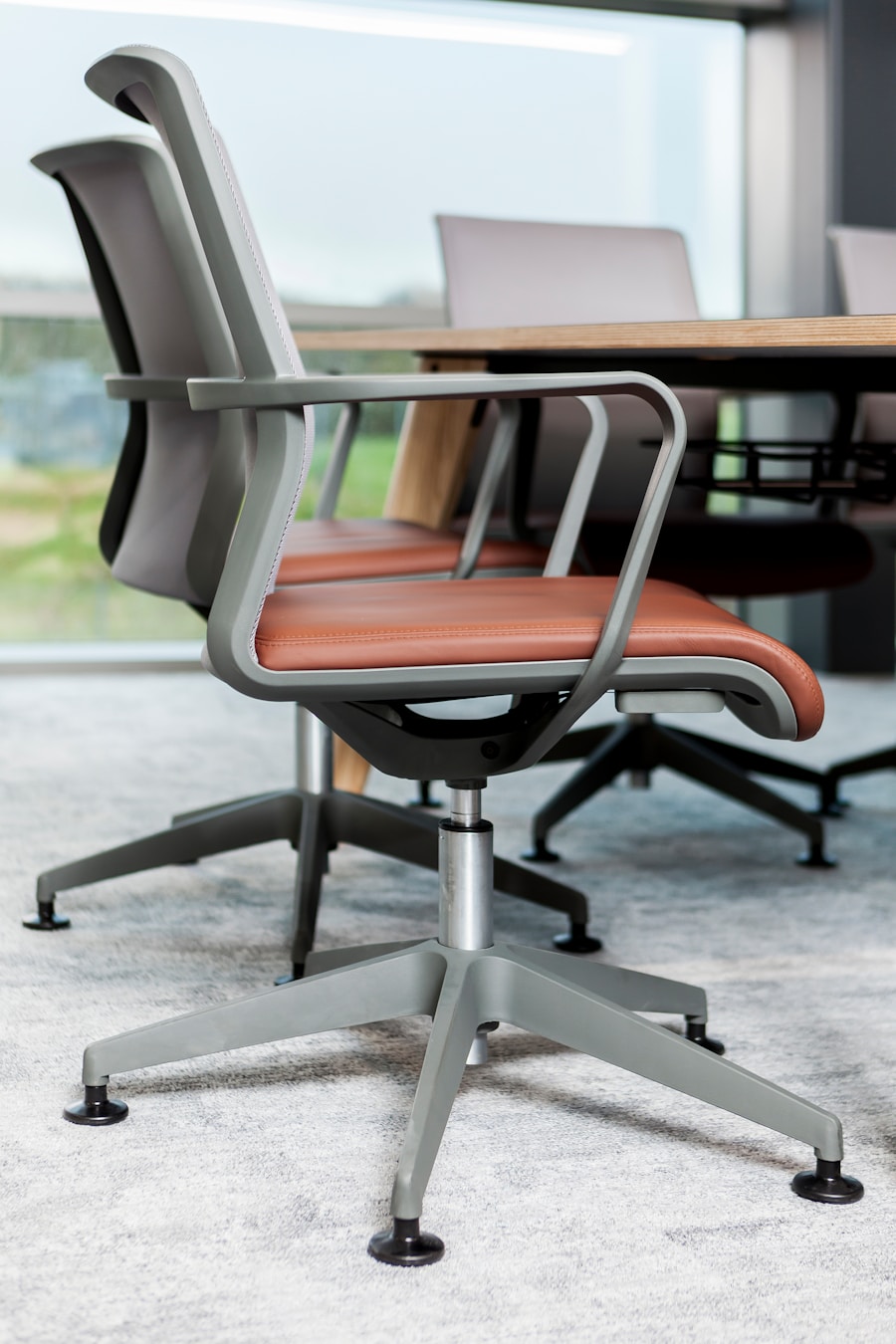The landscape of office furniture has undergone a significant transformation over the past few decades, evolving from traditional, rigid designs to more dynamic and versatile options that cater to the needs of contemporary work environments. Modern office furniture is characterized by its sleek lines, innovative materials, and multifunctional capabilities, reflecting the changing nature of work itself. As businesses adapt to new technologies and flexible work arrangements, the demand for furniture that supports collaboration, creativity, and comfort has surged.
This shift is not merely aesthetic; it represents a fundamental change in how we perceive and utilize office spaces. In today’s fast-paced world, where remote work and hybrid models are becoming the norm, modern office furniture plays a crucial role in enhancing productivity and employee well-being. The design of office furniture now prioritizes functionality and adaptability, allowing for easy reconfiguration of spaces to accommodate various tasks and team dynamics.
From open-plan layouts to private workstations, modern office furniture is designed to foster collaboration while also providing individuals with the privacy they need to focus. This article delves into the myriad benefits of modern office furniture, how to choose the right pieces for your space, and the latest trends shaping this essential aspect of workplace design.
Key Takeaways
- Modern office furniture is designed to be sleek, functional, and adaptable to the needs of a contemporary workplace.
- Benefits of modern office furniture include improved productivity, employee satisfaction, and a professional aesthetic.
- When choosing modern office furniture, consider the size and layout of your space, as well as the specific needs of your employees.
- Ergonomic design and comfort are important factors to consider when selecting modern office furniture to promote employee well-being.
- Incorporating technology into modern office furniture can enhance productivity and streamline workflow, such as built-in charging stations and cable management solutions.
Benefits of Modern Office Furniture
One of the most significant advantages of modern office furniture is its ability to enhance productivity. With an emphasis on functionality, many contemporary designs incorporate features that facilitate better workflow. For instance, height-adjustable desks allow employees to alternate between sitting and standing throughout the day, which can lead to increased energy levels and focus.
Additionally, modular furniture systems enable quick reconfiguration of workspaces, making it easier for teams to collaborate on projects or adapt to changing needs. This flexibility is particularly beneficial in environments where teamwork and communication are paramount. Moreover, modern office furniture often prioritizes aesthetics alongside functionality.
A well-designed workspace can significantly impact employee morale and satisfaction. Bright colors, innovative shapes, and unique materials can create an inviting atmosphere that inspires creativity and innovation. Companies that invest in attractive office furniture often find that it not only enhances their brand image but also attracts top talent who are looking for a stimulating work environment.
Furthermore, a thoughtfully designed space can reduce stress levels among employees, contributing to overall job satisfaction and retention rates.
Choosing the Right Modern Office Furniture for Your Space

Selecting the appropriate modern office furniture requires careful consideration of several factors, including the size of the space, the nature of the work being performed, and the company culture. For smaller offices, space-saving solutions such as compact desks or wall-mounted shelves can maximize functionality without sacrificing style. In contrast, larger offices may benefit from modular systems that allow for easy reconfiguration as teams grow or change.
Understanding the specific needs of your workforce is essential in making informed decisions about which pieces will best serve your organization. Another critical aspect to consider is the balance between individual workstations and collaborative spaces. While private offices or cubicles may be necessary for focused tasks, open areas equipped with communal tables or lounge seating can encourage teamwork and brainstorming sessions.
It’s also important to think about the flow of movement within the space; ensuring that pathways are clear and that furniture arrangements promote easy interaction among employees can significantly enhance workplace dynamics. By taking these factors into account, businesses can create a harmonious environment that supports both individual productivity and collective collaboration.
Ergonomic Design and Comfort in Modern Office Furniture
Ergonomics has become a cornerstone of modern office furniture design, reflecting a growing awareness of the importance of comfort in promoting employee health and productivity. Ergonomically designed chairs, for example, provide essential support for the back and neck, reducing the risk of musculoskeletal disorders that can arise from prolonged sitting. Features such as adjustable seat height, lumbar support, and armrests allow users to customize their seating experience according to their individual needs.
This attention to comfort not only enhances employee well-being but also contributes to increased focus and efficiency. In addition to chairs, other elements of modern office furniture are being designed with ergonomics in mind. Desks that allow for height adjustment enable users to alternate between sitting and standing positions throughout the day, which can help alleviate fatigue and improve circulation.
Accessories such as keyboard trays and monitor stands further promote proper posture by ensuring that screens are at eye level and that wrists are aligned correctly while typing. By investing in ergonomic furniture solutions, companies can create a healthier work environment that prioritizes employee comfort and reduces absenteeism due to health-related issues.
Incorporating Technology in Modern Office Furniture
As technology continues to evolve at a rapid pace, modern office furniture is increasingly being designed with integrated tech features that enhance functionality and connectivity. Desks equipped with built-in charging ports or wireless charging pads allow employees to keep their devices powered without cluttering their workspace with cords. Additionally, collaborative tables may come with integrated screens or video conferencing capabilities, facilitating seamless communication among team members regardless of their physical location.
Moreover, smart furniture solutions are emerging as a trend in modern office design. For instance, some desks now come with sensors that track usage patterns and remind users to take breaks or adjust their posture based on their sitting habits. This integration of technology not only streamlines workflows but also promotes healthier work practices by encouraging employees to be more mindful of their habits throughout the day.
As businesses continue to embrace digital transformation, incorporating technology into office furniture will be essential for creating efficient and future-ready workspaces.
Sustainable and Eco-Friendly Options in Modern Office Furniture

The growing emphasis on sustainability has led many manufacturers to prioritize eco-friendly materials and practices in their production processes. Modern office furniture is increasingly being made from recycled or sustainably sourced materials such as bamboo, reclaimed wood, or recycled plastics. These materials not only reduce environmental impact but also contribute to a healthier indoor air quality by minimizing harmful emissions associated with traditional manufacturing processes.
In addition to material choices, sustainable design principles are influencing how office furniture is constructed. Modular designs that allow for easy disassembly and recycling at the end of their life cycle are becoming more common. This approach not only reduces waste but also encourages companies to invest in long-lasting products rather than disposable options.
By choosing sustainable office furniture, businesses can demonstrate their commitment to environmental responsibility while also appealing to eco-conscious employees who value sustainability in their workplace.
Tips for Organizing and Maximizing Space with Modern Office Furniture
Effective organization is key to maximizing space in any office environment, particularly as businesses strive to create functional yet aesthetically pleasing workspaces. One effective strategy is to utilize multifunctional furniture pieces that serve multiple purposes; for example, storage ottomans can provide seating while also offering hidden storage for supplies or personal items. Similarly, desks with built-in shelving can help keep essential items within reach while minimizing clutter on the work surface.
Another important consideration is the layout of the office space itself. Open floor plans can benefit from designated zones for different activities—such as quiet areas for focused work and collaborative spaces for brainstorming sessions—allowing employees to choose environments that best suit their tasks at hand. Additionally, incorporating vertical storage solutions such as wall-mounted shelves or pegboards can free up valuable floor space while keeping essential items organized and accessible.
By thoughtfully arranging furniture and utilizing innovative storage solutions, businesses can create an efficient workspace that promotes productivity.
Trends in Modern Office Furniture Design
The world of modern office furniture design is constantly evolving, influenced by shifts in workplace culture, technological advancements, and changing employee expectations. One prominent trend is the move towards biophilic design—an approach that seeks to connect people with nature through natural materials, greenery, and organic shapes. Incorporating plants into office spaces not only enhances aesthetics but also improves air quality and boosts employee morale.
Another trend gaining traction is the emphasis on personalization within workspaces. Employees increasingly seek environments that reflect their individual styles and preferences; thus, customizable furniture options are becoming more popular. This could include adjustable desks that cater to different working styles or modular seating arrangements that allow teams to create their own collaborative spaces tailored to their needs.
As companies recognize the importance of fostering a sense of ownership among employees regarding their work environments, personalized design elements will likely continue to shape modern office furniture trends. In conclusion, modern office furniture represents a significant evolution in workplace design that prioritizes functionality, comfort, sustainability, and technology integration. As businesses navigate the complexities of contemporary work environments, investing in well-designed furniture solutions will be essential for creating spaces that enhance productivity while promoting employee well-being.
If you are interested in learning more about how modern office furniture design can impact your workspace, check out this article on modern office furniture design. This article discusses the importance of choosing the right furniture for your office to create a productive and comfortable work environment. It also provides tips on how to select furniture that promotes good health and safety practices in the workplace. Additionally, you may also want to read about workstation productivity tips in this related article: workstation productivity tips.
FAQs
What is modern office furniture?
Modern office furniture refers to furniture designed and manufactured in the contemporary style, often characterized by clean lines, minimalistic designs, and use of materials such as metal, glass, and wood. It is designed to create a sleek and functional workspace.
What are the benefits of modern office furniture?
Modern office furniture is designed to maximize space and functionality, making it ideal for small or open-plan offices. It also creates a professional and stylish work environment, which can improve employee morale and productivity.
What are some common features of modern office furniture?
Common features of modern office furniture include ergonomic designs for comfort, adjustable components for customization, and integrated technology solutions such as built-in charging ports and cable management systems.
What are some popular materials used in modern office furniture?
Popular materials used in modern office furniture include metal, glass, wood, and high-quality plastics. These materials are often combined to create sleek and durable furniture pieces.
How can modern office furniture be customized to fit different office spaces?
Modern office furniture often comes with modular components that can be rearranged and reconfigured to fit different office layouts. Additionally, many manufacturers offer customization options such as color choices and additional accessories to tailor the furniture to specific needs.


